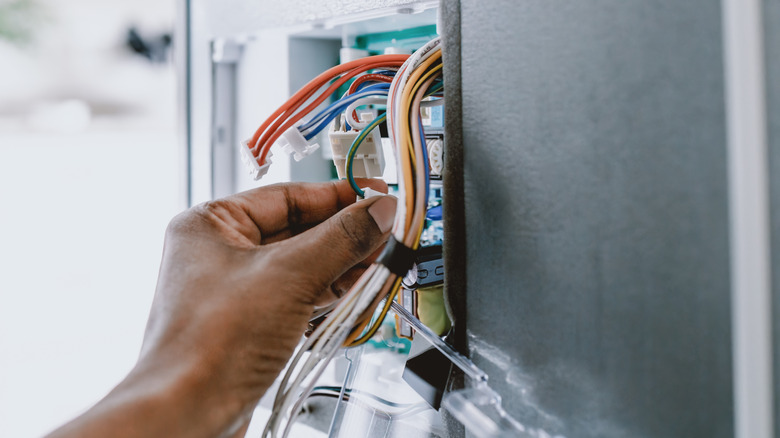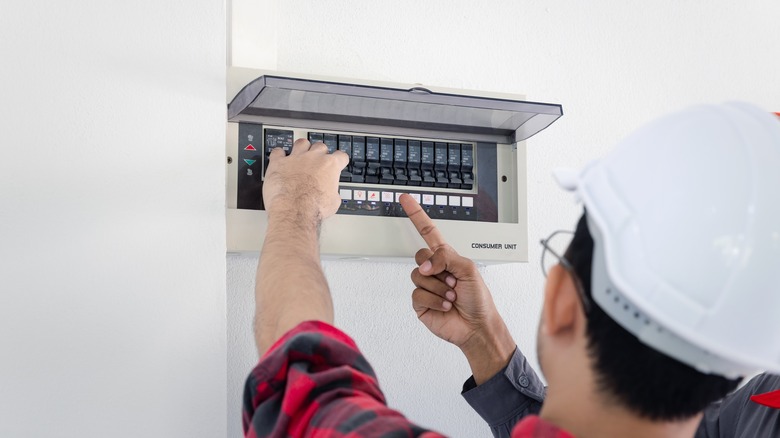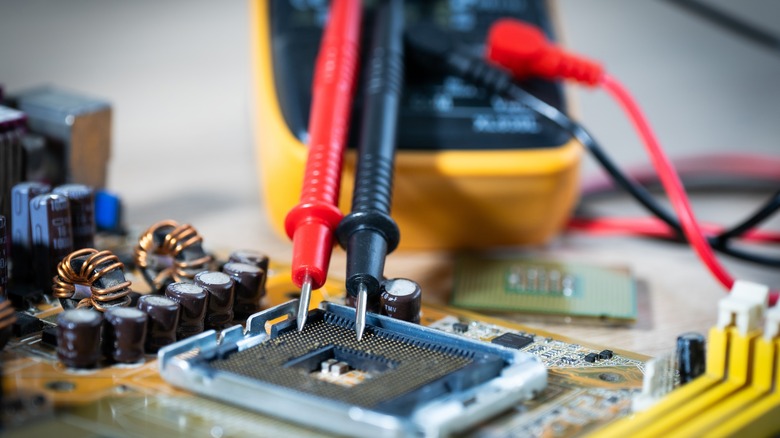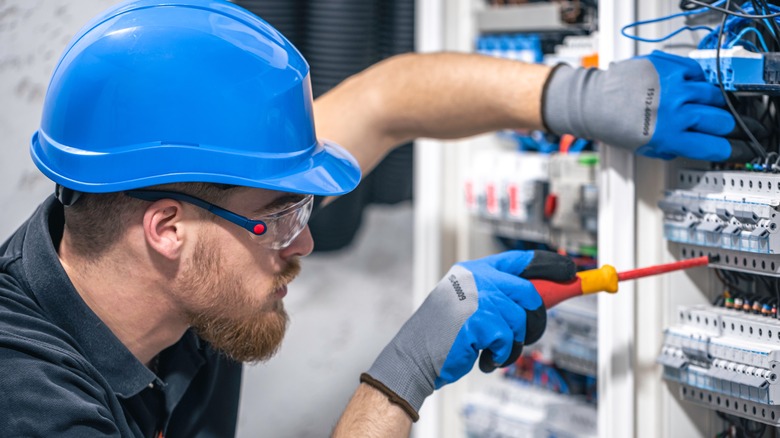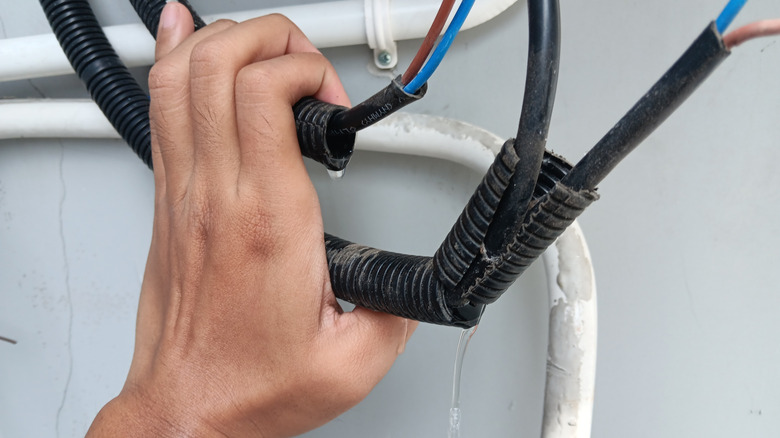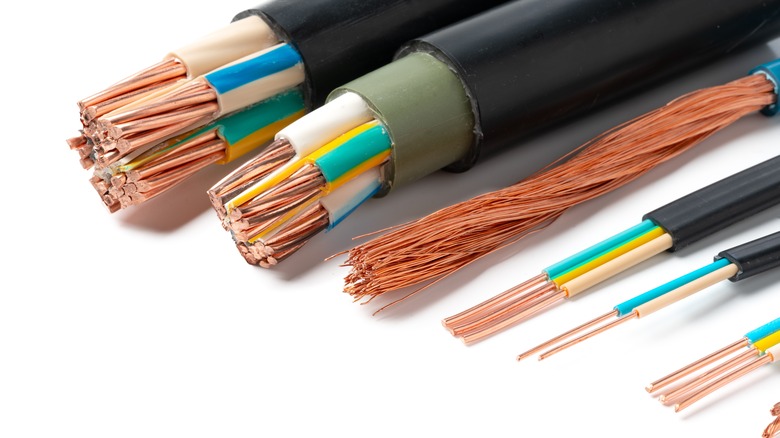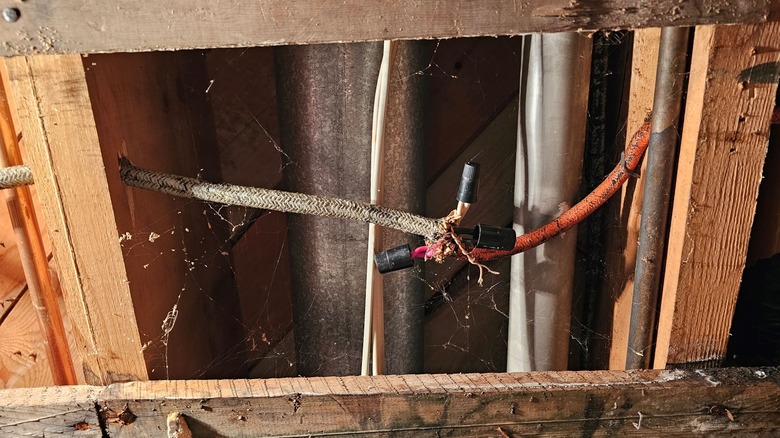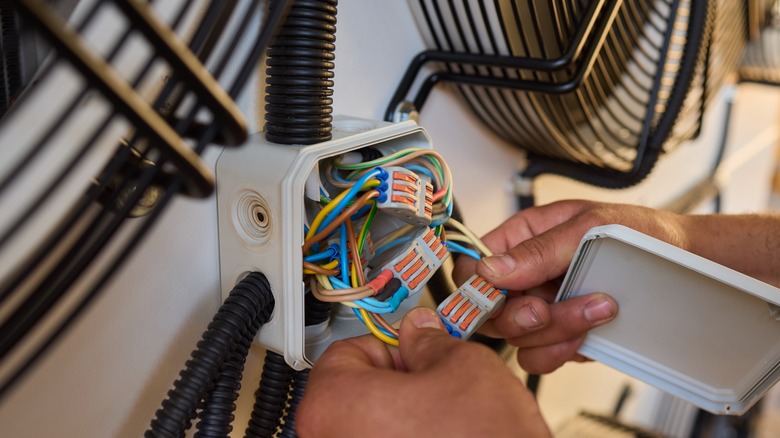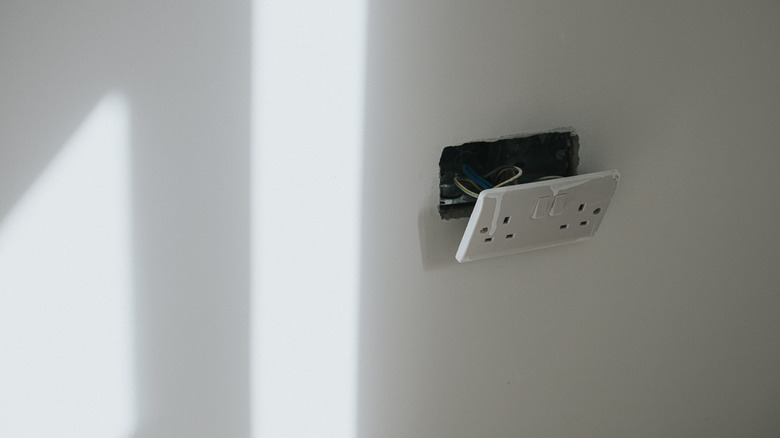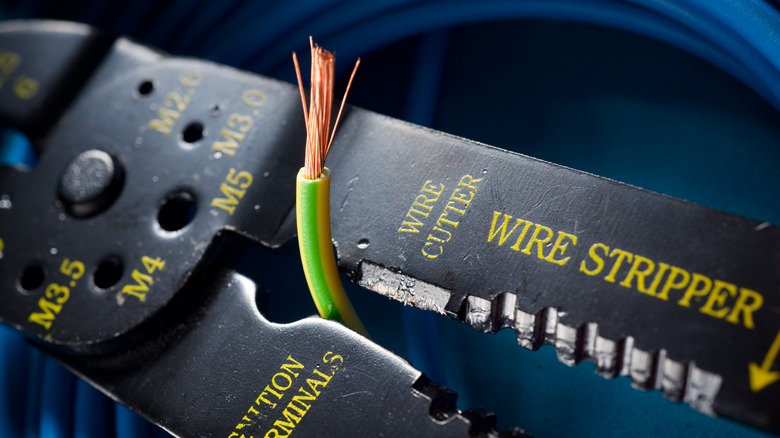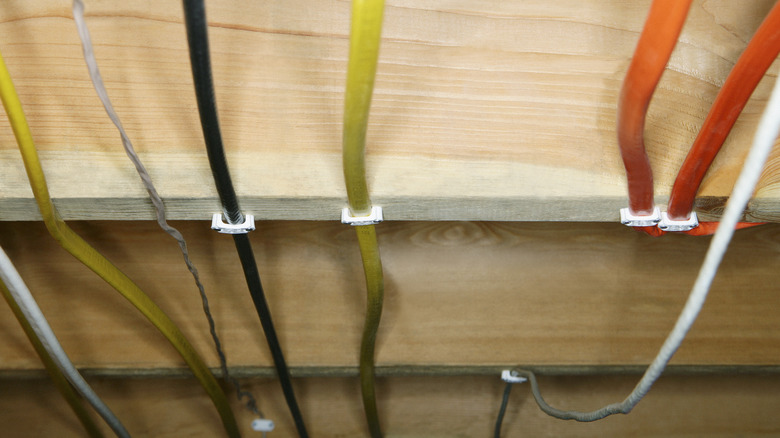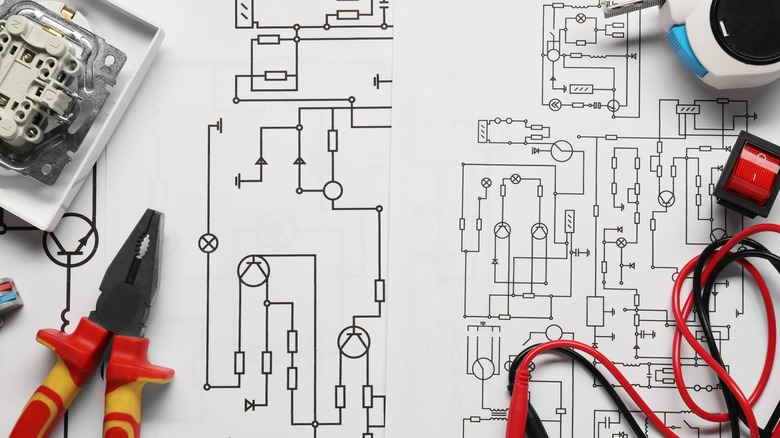13 Of The Worst Mistakes You Can Make When Doing Electrical Work
The allure of performing electrical repairs on your own is strong. There's a tactile response to killing the power and installing something new in your home without the help of a professional. Knowing that you accomplished the installation of a new light fixture or the addition of an outlet on your own is empowering and often a point of pride, but there's a lot to keep square in your mind as you approach even the simplest electrical tasks. At a minimum, you're working with a dangerous asset that can hurt you or even lead to fatal consequences if you aren't careful.
A shock is no joke, even when its a little tingle from a low voltage line. There's also the aftereffects to keep in mind. Incorrectly performing electrical work introduces major problems into your home that can be disastrous. I've been tackling electrical jobs for years. In particular, when buying our first home I was ultimately tasked with rewiring much of the (old) house because it only featured a single outlet in each room.
I'm not an electrician, but I do have lots of experience and confidence in tackling these kinds of jobs. Some of these issues I've learned the hard way, and others I've been fortunate enough to avoid altogether.
Failing to cut power before starting your job
The first thing that must be done as you prepare to work on any electrical system is identifying the main power source. Cutting the power serves as both a practical measure to help support your efforts and a safety precaution that will keep you from getting injured or worse. This first step remains in effect regardless of whether you are making upgrades in your home or working on a consumer electronic device like an appliance or computer. Disconnecting the power source or switching your circuit breaker off before you start work protects the system from unexpected discharge and prevents you from getting shocked in the process.
This step is so incredibly easy to accomplish. However, inexperienced renovators and repairers might think that they can get away with tackling a small electrical job without switching off the power. The reality is that the only way to ensure your work area is safe for both you and the components you're working with is to kill the power during the job.
Thinking you don't need voltage testers and multimeters on hand
One simple way to test that your power is out is to attempt to use an appliance or turn on a switch. However, there's a better way to ensure you're actually working with an inert electrical fixture. Voltage testers and multimeters are essential diagnostic tools that electricians use regularly. Voltage testers come in a range of options. There are pen devices that you place near an outlet to test for electrical current as well as plug in detectors that you stick right into a socket in order to check if it's still live.
Multimeters are a different sort of tool. This is a diagnostic asset that helps confirm a wire isn't carrying live current, but it can do so much more; Multimeters are crucial for testing resistance and checking voltage, among others (you can even use one during car repairs or to test to see if batteries are actually tapped out). They come in basic formats, but for more in-depth electronics repair works, a more capable multimeter will be your best friend. These tools are particularly important for anyone working on older homes. The older the home, the more likely you are to encounter unexpected twists. You may encounter color coding that doesn't match modern standards or potentially even run into wires that are the same color, leaving you the task of figuring out the live conduit.
Working without essential protective equipment
Safety equipment is an essential inclusion while working on literally any kind of renovation project or repair operation. There's no getting around the need to protect your eyes with safety glasses and cover your ears when cutting boards with a circular saw, or strapping on a mask when sanding a piece of furniture or cabinet. Basic protective equipment helps you get the job done safely in the moment and with minimal risk to your long-term health. Naturally, lots of protective solutions make their way into electrical repairs.
For starters, even with the power off, you won't want to climb up on an aluminum ladder with no rubberized components when installing a new light fixture or working on any other kind of wiring that may be high up on the wall. Standing on a metal platform without any sort of grounding or mitigating features can introduce static into the mix and put you at risk of injury.
Another important piece of protective equipment is your choice of shoes. Shoes with rubber soles or another critical inclusion when dealing with electrical systems. You'll likely want to wear eye protection if you're performing even small cuts. Of course, the addition of insulated tools will help protect you from electrical discharge, adding another safety wrinkle into the equation.
Working around water
Water is your biggest enemy when performing electrical repair. Electricity and water simply don't mix, and if your workspace is wet, you absolutely must stop working on whatever you're doing and address that problem first. Even professional electricians balk at wiring an appliance or socket if the workspace isn't completely dry.
The problem here is twofold. Your immediate safety cannot be assured if you work in wet conditions. That's obviously a big deal and one that needs to be addressed as you work through whatever task you might have on your plate. However, another issue comes into the picture after you've finished performing your installation or repair. By placing a new socket or a wired appliance in a spot that is susceptible to pooling water or condensation, you are introducing an electrical system into an unsafe environment. This new installation may come into contact with standing water or get dripped on slowly over time, enhancing the potential for an electrical fire or some other type of failure that can be catastrophic to your family and home.
Incorrect sizing when selecting wiring
Selecting the right size for your wire is an important task regardless of the job parameters. It's worth noting that this problem comes in two flavors. If you choose a wire that is too big for the job you require of it, you aren't necessarily introducing a hazard, but you will be wasting money on a more expensive wire product that you just don't need. This is a functional problem that impacts your budget and may end up creating installation difficulties as you work to finesse a firm or thick wire into position when dealing with nuanced electrical works.
The other end of the spectrum is dangerous. If you use a wire that is too small for the required task you will end up running into problems maintaining consistent current. You're likely to have your circuit breaker trip on a regular basis as the wire fails to handle the required current that connected devices attempt to draw. In addition to continuity problems, this also creates a fire hazard within your walls. Wiring that isn't up to the task can easily overheat and introduces a serious risk of fire as a result. Generally speaking, 14-gauge wire is used to carry 15 amps and supports fans, lighting, and basic outlets, while 12-gauge wire is required for higher current operations like those in the kitchen and bathrooms. These support larger appliances and can carry 20 amps. Even greater needs like the draw for an EV home charger will demand a thicker wire again.
Making poor connections when splicing wires or installing terminals
Loose connections are a major problem and tend to be found primarily within the world of DIY electrical repairs. Creating a firm connection is a subtask within the conversation of electrical installation that can easily be overlooked. Pros don't tend to make this mistake, but it's actually very easy to leave your connections too lax.
If your wiring isn't firmly in place, you can end up with a shaky circuit that can become a shock hazard or even increase your fire risk. Loose connections can easily introduce a live wire into the open environment. It just takes a bit of bad luck for this to turn into a major problem. You'll also want to ensure that you aren't reversing the polarity when installing new elements in your wiring system. Connecting the live wire to anything other than the live terminal on an outlet or light can bring about similar risks as a loose wire floating around in open space. No matter what connection you are trying to make whether it's at the outlet side or midstream along a supply wire's run, ensuring a firm connection that isn't going to come loose is critical.
Attempting to wire up a project without junction boxes
On the subject of correct connections, it's important to ensure that you are always working with the right equipment for the task. The tools you use are obviously important, but the components themselves make all the difference. Whether you're a professional or DIY'er, one particular material it's crucial for getting the job done and needs to be part of your workflow. A junction box is something you can theoretically do without. Adding a junction box brings a few major advantages, and it's simply the right way to tackle the job.
First of all, these boxes tend to be fire-rated. They're often built out of plastic but incorporate a heat resistance that helps mitigate the risk of a meltdown. Beyond the safety of the actual wiring, junction boxes also help manage what would otherwise be an unruly tangle of lines. Even a simple wiring diagram can easily become a Gordian knot over time. Utilizing junction boxes places all of your connections inside a protective housing and gives you a node that is secured to a beam or stud.
Placing too many terminals on a single circuit
It's important to consult your local codes and regulations when considering any alteration to your home's wiring. This is a practical matter that helps you remain within compliance of the rules governing your community. It might sound silly in some cases, but there are many reasons for maintaining building code compliance. Suppose you want to sell your home in the future. In that case, anything you do to the property that doesn't meet regulations may ultimately create problems for a potential buyer or act as a means to potentially reduce the sale value.
Your local building code will stipulate all sorts of regulations that should be a part of your renovation process. One important area involves the number of outlets you can place on a single circuit. If you need to, adding new lines to the fuse box is always possible, but this is certainly a much larger job than just extending a circuit to add another plug. It's easy to think that maintaining compliance with this rule isn't a big deal. After all, you aren't likely to turn on electrical systems in every plug along a circuit at the same time. The problem is that you could if you wanted to, and overloading a circuit is a great way to end up with a hazardous home. Moreover, the longer this kind of ticking time bomb remains in effect the less you remember any self-imposed constraints placed upon the system.
Failing to ground the system properly (or using your earth wire to carry a current)
The ground wire is not a suggestion. An ungrounded plug can discharge its current out into the things plugged into it or directly into you, the user. Failing to ground your newly installed appliances, outlets, or otherwise is a recipe for disaster. You might not get shocked immediately, but you'll almost certainly take an electrical current at some point in the future. Those with pets, small children, or a penchant for hosting visitors have an even greater risk of potential harm from these kinds of improper installations.
Another major issue involving the ground wire comes while using it in an unsafe manner. You should absolutely never use a ground wire to carry current. Ground wires should never be substituted for those colored with a live or neutral outer sheath. These current-carrying tools are color-coded in such a way so that you'll immediately know what you're looking at when breaking into a wall or pulling up a wire to do repairs in the attic. If you've used wiring in an improper manner it's much harder to keep track of which line is carrying current. This immediately boosts the risk of shocks and injury. One final problem is in mixing a ground wire into your live lines. Live wires that touch the ground circuit can ultimately electrify any number of metal components found throughout your home. This makes the property a genuine hazard for anyone walking around within its walls.
Failing to secure loose wiring once the main thrust of a job is complete
A loose connection is problematic, but not the only issue regarding poorly secured wiring. Once you've finished connecting in your new installation, you'll want to turn the power back on to test the work. Still, flipping the switch and confirming a job well done doesn't mean you're finished.
The next step here is to turn the power back off and head back to the project. Wiring in the attic and lines that run partially or completely exposed along the ceiling or around other elements of the house will need to be fastened to nearby surfaces. A simple box of wire clips is all you'll need to get this job done. They frequently come with a hook component and a small nail that you can tack into place on rafters, studs, or elsewhere. Securing wires eliminates the potential for a tripping hazard. Anything in your home that can be pulled or tripped over creates a problem. This becomes magnified when that thing is carrying live current. You might even trip over a wire with enough force to break the connection somewhere along its route or tear through the protective outer covering and shock yourself. This isn't just an aesthetic finalizing touch but one that introduces critical safety.
Improper planning ahead of a job
Wiring jobs are all about preparation. Even on simple jobs, it's incredibly easy to get lost once you start making cuts and stripping wire ends. Failing to properly account for the scope of the task can easily leave you reeling. For one thing, electrical work almost always takes longer than you expect. In many cases, wiring is found in difficult-to-reach areas that require you to contort your body or reach back into spaces that you can't see very well. The physicality of any electrical job elongates the task and frequently makes it a more frustrating affair than is seemingly necessary.
Add to this a confusion about which wire runs to what endpoint, and you'll drastically change the outlook of even a basic rewiring job. Planning ahead means getting all the required materials so you don't have to run back to the home improvement store for more gear. This also involves drawing up a rough plan of what you are doing. Creating a diagram of the task at hand allows you to keep everything straight in your head. Getting electrical wiring wrong can be catastrophic, so taking your time and drawing up exactly what you will do helps mitigate risk.
Ignoring installation instructions
Regardless of your skill or experience with an insulated screwdriver and the level of difficulty inherent to the job, it's important to read the installation instructions that come with whatever product you are handling. A new light, an updated power outlet, and more all come with basic user documentation. You may have installed plenty of lights and outlets in your time, but each product is unique and features its own method of accessing the wiring terminals. Sometimes, you may even deal with unfamiliar symbols rather than lettering elements on the connection terminals.
Installation instructions also frequently include information about wire gauge, diagrams for breaking into a switching line, or best practices for orienting a wire to create a secure connection. Even if you've done it all before, it's worth taking a few moments to read over the documentation to gain specific knowledge about the thing you'll be working with.
Failing to heed warning signs (before, during, or after your work)
Warning signs are everywhere when it comes to electrical systems. The electrical network in your home is built with redundancies in place and safety measures throughout. This means that before a faulty wire bursts into flames, it will give you signs that something is failing. Oftentimes, a wiring issue rears its head in the form of a flickering light or even a burning smell somewhere along its route. Another issue to watch out for is frequent switch tripping in the circuit breakers.
These sorts of problems don't happen in a vacuum. If nothing has changed, your home won't suddenly start showing signs that your electrical system is experiencing a new and unacceptable load. These kinds of signs show that a change needs to be made. This can happen before you begin the repair work, necessitating that work in the first place. You'll frequently want to look for these kinds of issues during your upgrade and directly after it. If you start smelling something burning right after you install a new light fixture, it might be a definitive sign that you have done the job wrong.
